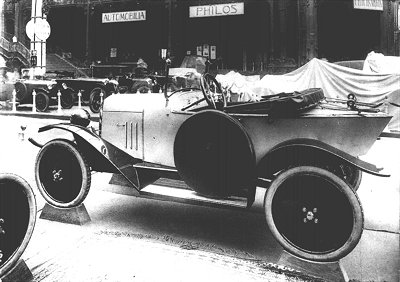|
Citroën Type C 5HP
The Citroën Type C was a light car made by the French Citroën car company between 1922 and 1926 with almost 81,000 units being made. Known as Citroën Tax horsepower, 5HP or 5CV in France and 7.5HP in Britain, it was the second model of automobile designed and marketed by André Citroën, between 1922 and 1926. It followed the 10HP "Type A " (1919), then 10HP "B2" (1921); they were the first European mass-produced cars. The first colour in which it was made was a pale "grapefruit" yellow which earned it the first nickname "petite citron" (little lemon). It was also nicknamed "Cul de poule" (hen's bottom) or "boat tail" due to the rear of the little car's body and also "Trefle" (clover leaf) referring to the shape of the three-seat version. History Sources The genesis of the Type C took place in the immediate post-war period, when the whole of Europe was in a disastrous state, especially economically, with relentless inflation reducing the value of savings and investme ... [...More Info...] [...Related Items...] OR: [Wikipedia] [Google] [Baidu] |
Citroën
Citroën ()The double-dot diacritic over the 'e' is a diaeresis () indicating the two vowels are sounded separately, and not as a diphthong. is a French automobile brand. The "Automobiles Citroën" manufacturing company was founded on 4 June 1919 by André Citroën. Citroën has been owned by Stellantis since 2021 and previously was part of the PSA Group after Peugeot acquired 89.95% share in 1976. Citroën's head office is located in the Stellantis Poissy Plant in Saint-Ouen-sur-Seine since 2021 (previously in Rueil-Malmaison) and its offices studies and research in Vélizy-Villacoublay, Poissy (CEMR), Carrières-sous-Poissy and Sochaux-Montbéliard. In 1934, the firm established its reputation for innovative technology with the Citroën Traction Avant, Traction Avant. This was the world's first car to be mass-produced with front-wheel drive and four-wheel independent suspension, as well as unibody construction, omitting a separate chassis, and instead using the body of the car ... [...More Info...] [...Related Items...] OR: [Wikipedia] [Google] [Baidu] |
Citroën Vehicles
Citroën ()The double-dot diacritic over the 'e' is a diaeresis () indicating the two vowels are sounded separately, and not as a diphthong. is a French automobile brand. The "Automobiles Citroën" manufacturing company was founded on 4 June 1919 by André Citroën. Citroën has been owned by Stellantis since 2021 and previously was part of the PSA Group after Peugeot acquired 89.95% share in 1976. Citroën's head office is located in the Stellantis Poissy Plant in Saint-Ouen-sur-Seine since 2021 (previously in Rueil-Malmaison) and its offices studies and research in Vélizy-Villacoublay, Poissy (CEMR), Carrières-sous-Poissy and Sochaux-Montbéliard. In 1934, the firm established its reputation for innovative technology with the Traction Avant. This was the world's first car to be mass-produced with front-wheel drive and four-wheel independent suspension, as well as unibody construction, omitting a separate chassis, and instead using the body of the car itself as its main load- ... [...More Info...] [...Related Items...] OR: [Wikipedia] [Google] [Baidu] |
5HP VL 23 1gr Citroen 5HP Voiture De Livraison 125 Kg
5HP is ZF Friedrichshafen AG's trademark name for its 5-speed automatic transmission models (5-speed transmission with Hydraulic converter and Planetary gearsets) for longitudinal engine applications, designed and built by ZF's subsidiary in Saarbrücken. Specifications Final Conventionally Designed Gearbox With planetary gearboxes, the number of gears can be increased conventionally by adding additional gearsets as well as brakes and clutches, or conceptually by switching from serial to parallel power flow. The conceptual way requires a computer-aided design. The 5HP is the last transmission family with serial power flow: to provide more gears, components were added. This makes these transmissions larger, heavier and even more expensive to manufacture. As the presence of 10 main components (together with brakes and clutches) in the Ravigneaux gearbox types shows, this meant the end of the conventional gearbox design. The approach of the all new Lepelletier gear mech ... [...More Info...] [...Related Items...] OR: [Wikipedia] [Google] [Baidu] |
5HP T3-1 23 1gr
5HP is ZF Friedrichshafen AG's trademark name for its 5-speed automatic transmission models (5-speed transmission with Hydraulic converter and Planetary gearsets) for longitudinal engine applications, designed and built by ZF's subsidiary in Saarbrücken. Specifications Final Conventionally Designed Gearbox With planetary gearboxes, the number of gears can be increased conventionally by adding additional gearsets as well as brakes and clutches, or conceptually by switching from serial to parallel power flow. The conceptual way requires a computer-aided design. The 5HP is the last transmission family with serial power flow: to provide more gears, components were added. This makes these transmissions larger, heavier and even more expensive to manufacture. As the presence of 10 main components (together with brakes and clutches) in the Ravigneaux gearbox types shows, this meant the end of the conventional gearbox design. The approach of the all new Lepelletier gear mech ... [...More Info...] [...Related Items...] OR: [Wikipedia] [Google] [Baidu] |

